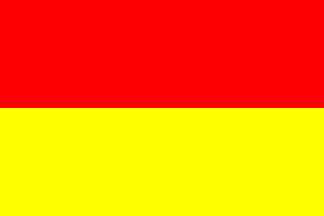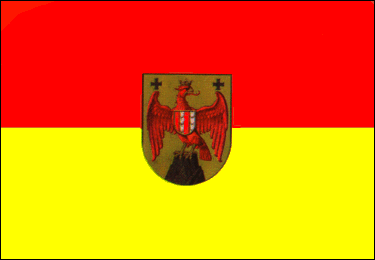

adopted 25 June 1971

Last modified: 2025-11-22 by martin karner
Keywords: burgenland | cross: greek | eagle (red) | fur (white) | land |
landesfarben | state flag | state service flag | bicolour: red-yellow |
Links: FOTW homepage |
search |
disclaimer and copyright |
write us |
mirrors

|

|
| image by Jan Oskar Engene |
image by Peter Diem |
adopted 25 June 1971 |
See also:
Burgenland is a very young Austrian province. It was founded in 1921 after the Treaty of Trianon, which annexed
this territory to Austria from Hungary. The new province lived to 1938 (Anschluss), and after World War II it was reborn.
István Molnár, 13 June 2000
Burgenland is home to more than 8000 ethnic Hungarians. More than 30% of the
inhabitants live in four settlements: Unterwart/Alsóor, Oberwart/Felsoor,
Oberpullendorf/Felsopulya and Siget in der Wart/Orisziget. They use the Hungarian flag on the
Hungarian national holidays.
István Molnár, 5 June 2001
This is interesting, since Burgenland
was transferred from Hungary to Austria following the First World War, because
of its predominantly German speaking population. It was the only territorial
gain for Austria following that war (at the same time she lost a lot more
territory to Czechoslovakia, Poland, Yugoslavia (a country which hadn't got that name
yet), Italy, Romania ...).
Elias Granqvist, 5 June 2001
In Die Symbole Österreichs by Peter Diem [die95]
the field of the arms is shown as gold, while the bottom field of the flag is yellow.
Jan Oskar Engene,
11 April 1996
Or, standing upon a rock sable an eagle regardant wings displayed
gules, langued of the same, crowned and armed of the first, on his breast an escutcheon paly of four, of the third and white fur,
fimbriated of the field, and in dexter and sinister cantons two crosslets paty sable – which means:
In yellow a red eagle, looking to its left,
with a golden crown standing on a black rock, escutcheon with vertical bars red and
white fur, over each wing a black Greek cross.
Joe McMillan, 18 March 2002
The "white fur" on the
stripes of the shield is in German Kürsch.
Peter Diem, 26 August 2002
Official description (transl. by Google): "The coat of arms of Burgenland is a red, gold-crowned and
clawed, red-tongued, looking-back eagle with outstretched wings, standing on a black rock,
accompanied in the upper corners by two black, broad-pointed crosses, and whose breast is
charged with a small shield divided three times by red and Kürsch
and bordered in gold. It can be displayed in color or in black and white." (Law from 15 November 1990
about the state symbols of Burgenland, Landesgesetzblatt 16/1991, §2;
source)
Martin Karner